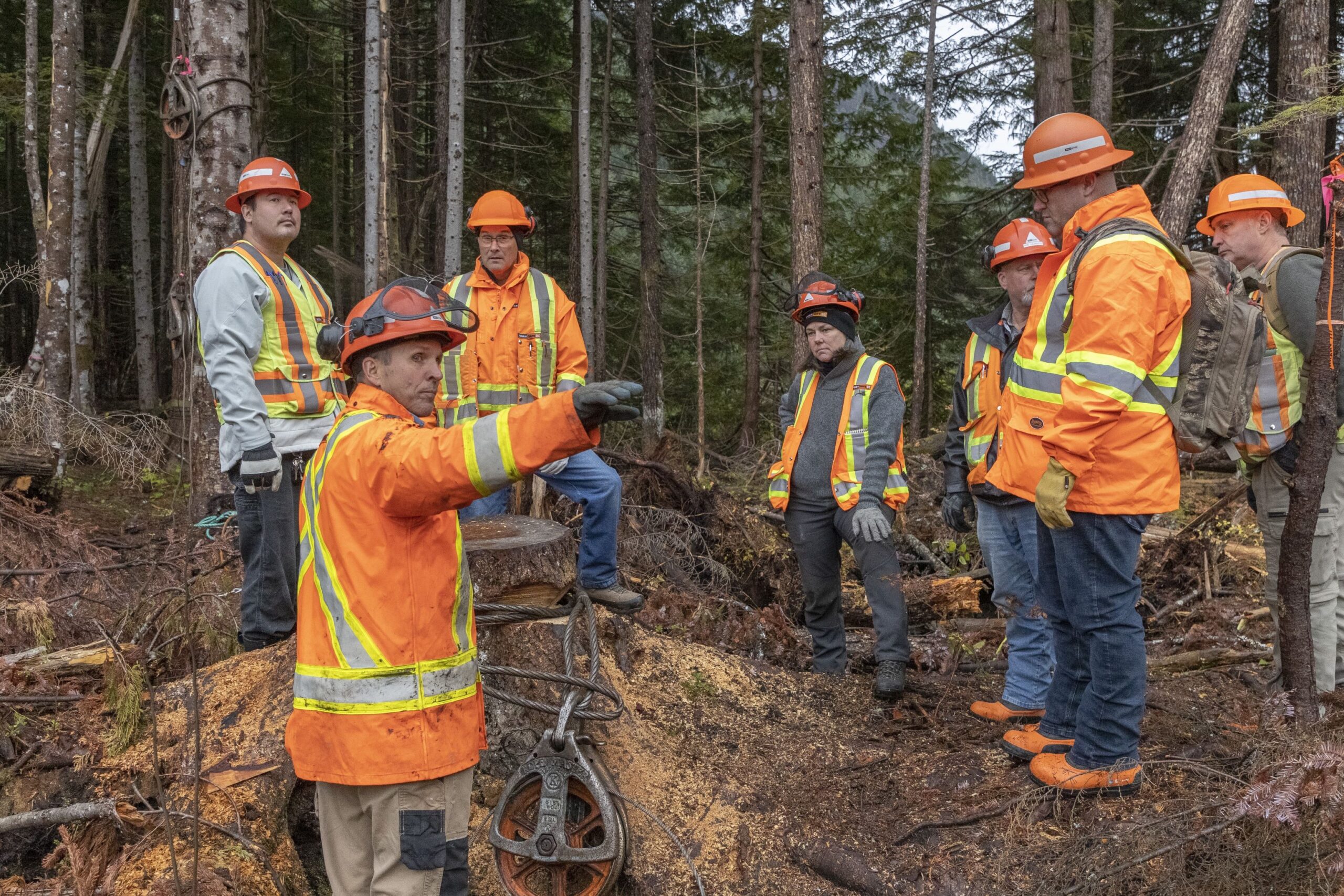
Steep slope harvesting (SSH) enables forestry operations on challenging and often hazardous terrain, allowing access to valuable timber resources. But with this access comes increased risk. From equipment instability to terrain hazards, safe operations on steep ground require a clear understanding of the work environment and strong mitigation strategies.
Approaches to steep slope harvesting
Steep slope harvesting can be approached in several ways, each with its own set of challenges and safety considerations.
- The first approach uses conventional equipment, guided by a risk assessment and safe work procedures developed by a qualified person. The BC Forest Safety Council’s Steep Slope Resource Package helps employers and workers create site-specific procedures.
- The second approach involves specialized equipment, such as tethered or winch-assist machines, designed for steep terrain and capable of operating on slopes up to 100% grade with cable support for stability.
- The third method, cable yarding or high-lead logging, moves logs across slopes over 100%, minimizing the need for ground-based equipment on unstable terrain. However, cable yarding introduces its own high-risk factors and must be part of the safety plan.
- Other specialized approaches, such as heli-logging, are also used in terrain too steep or sensitive for ground-based equipment.

Key hazards
Terrain instability
Conditions can shift rapidly on steep slopes. Operators must be able to recognize changing hazards and respond appropriately. Assessing slope steepness, ground stability, and preparing for emergencies is essential.
Inadequate planning
Planning should include detailed mapping of terrain features such as slope gradients, soil types, and unstable areas caused by moisture, rock outcrops, or past slides. Clearly marked no-go zones are critical where equipment use would be too dangerous.
Strengthening risk assessments
A qualified person—or team—must conduct a thorough assessment of both terrain and equipment limits. This forms the basis for site-specific safe work procedures to maintain machine stability and protect worker safety.
Natural obstacles
Cliffs, gullies, and loose debris pose serious risks. Workers and supervisors should walk the site before operations begin to spot hazards and confirm that equipment anchoring will be secure.
Machinery hazards
Equipment on steep slopes is vulnerable to rollovers and traction loss, especially if support cables are damaged by sharp objects like rocks, stumps, or machinery components such as a buncher head.
Machinery must always be suited to the terrain,” says Tom Pawlowski, manager of Prevention Programs and Services at WorkSafeBC. “For example, rubber-tired machines are typically limited to slopes of 35%, so it’s critical to match the right equipment to the right slope.
Stay clear, stay safe: Cable yarding on slopes
Cable yarding—using a system of cables and blocks to move logs from the cutting site to the landing—is a common and efficient technique in steep slope harvesting. But it comes with serious safety risks, especially when workers are near moving logs, tensioned lines, or heavy equipment.
Proper planning and setup of cable systems are crucial for worker safety. Even small oversights, like improperly anchored guylines or missed maintenance, can lead to dangerous, uncontrolled movements.
Key practices for mitigating risks
Hazard assessment and equipment suitability
Start with a thorough evaluation of the terrain—consider slope steepness, ground stability, and the potential for equipment failure. This will form the basis of your site harvesting and safety plan. Only use machinery rated for the conditions. Cable yarding operators should confirm all rigging, anchors, and pulleys are suited to the slope and securely installed.
Effective setup and anchoring
Proper anchoring and setup of machinery and cable systems are critical. All equipment must be securely anchored, and deflection systems adjusted to maintain safe angles. Make sure to regularly inspect and adjust equipment based on terrain changes.
Staying in the clear
A core safety principle in steep slope harvesting is maintaining safe distance. Workers must stay at least 1.5 tree lengths away from moving logs or equipment. If this can’t be maintained, work must stop until the plan is adjusted and risks are properly managed. Ongoing awareness and clear communication are essential to staying out of harm’s way.
Communication and emergency response
Effective communication is key. Daily tailgate meetings should review hazards and safety protocols, while supervisors must monitor conditions and ensure workers are familiar with emergency procedures.
WorkSafeBC requires that emergency procedures be practiced whenever there is a significant change in location or harvesting process.
Maintaining equipment
Preventative maintenance plays a major role in safety. Conduct regular checks, follow lockout procedures, and inspect for wear or damage—especially in equipment used on steep terrain.
Personal safety measures
Workers should wear seatbelts, use proper footwear, and secure loose items inside cabs to minimize risks like slips, trips, and uncontrolled movement in the event of equipment failure.
Creating a safety culture: The role of supervisors
While equipment, planning, and procedures are essential, the foundation of a safe worksite is a shared commitment to health and safety, starting from the top.
“The responsibility of a supervisor extends beyond operations,” says Pawlowski. “They play a key role in fostering a mindset that prioritizes worker well-being.”
The way supervisors approach safety directly influences the attitudes and behaviours of the crew. Supervisors must be present, well-trained, and action-oriented, creating an environment where workers understand their responsibilities and feel supported in speaking up. Supervisors must model open communication, respond quickly to health and safety issues, and ensure workers are equipped to recognize and manage hazards throughout the phases of a project.
Safe outcomes depend on daily actions
Steep slope harvesting presents significant risks, but with careful planning, proper equipment, and a culture of safety, these risks can be managed.
“Safety is not a one-time effort but an ongoing process that requires daily attention,” says Pawlowski. “By consistently prioritizing hazard assessment, equipment suitability, proper setup, and staying in the clear, employers and workers can minimize risks and help ensure that steep slope harvesting remains a safe and effective method of timber harvesting.”
For more information consult resources from the BC Forest Safety Council and WorkSafeBC.